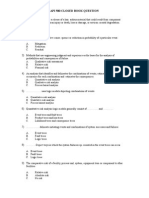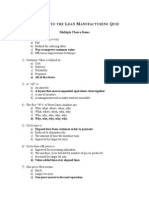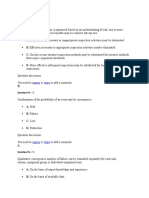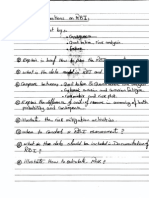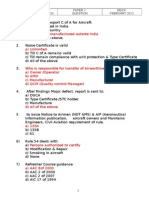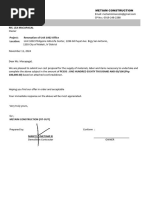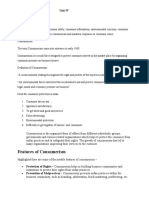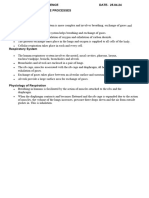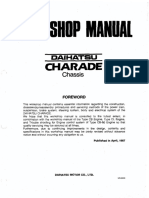0 ratings0% found this document useful (0 votes)
Risk Based Inspection Question Bank
Risk Based Inspection Question Bank
Uploaded by
traja41. Probability of failure analysis in risk-based inspection (RBI) is determined by a blend of qualitative and quantitative assessments, including knowledge of operating history, inspection plans, and possible material deteriorations.
2. The probability of failure and deterioration rates are assessed based on grouping equipment by similar materials, processes, and environments. Published data and experience with other similar equipment can also be used when no inspection data is available.
3. Consequence analysis aids in risk ranking of equipment and understanding potential impacts. It focuses on acute toxic risks rather than chronic low-level risks. Risk is calculated as the product of probability and consequences.
Copyright:
© All Rights Reserved
Available Formats
Download as DOC, PDF, TXT or read online from Scribd
Download as doc, pdf, or txt
Risk Based Inspection Question Bank
Risk Based Inspection Question Bank
Uploaded by
traja40 ratings0% found this document useful (0 votes)
1. Probability of failure analysis in risk-based inspection (RBI) is determined by a blend of qualitative and quantitative assessments, including knowledge of operating history, inspection plans, and possible material deteriorations.
2. The probability of failure and deterioration rates are assessed based on grouping equipment by similar materials, processes, and environments. Published data and experience with other similar equipment can also be used when no inspection data is available.
3. Consequence analysis aids in risk ranking of equipment and understanding potential impacts. It focuses on acute toxic risks rather than chronic low-level risks. Risk is calculated as the product of probability and consequences.
Original Title
API580_-_QB_1
Copyright
© © All Rights Reserved
Available Formats
DOC, PDF, TXT or read online from Scribd
Share this document
Did you find this document useful?
Is this content inappropriate?
1. Probability of failure analysis in risk-based inspection (RBI) is determined by a blend of qualitative and quantitative assessments, including knowledge of operating history, inspection plans, and possible material deteriorations.
2. The probability of failure and deterioration rates are assessed based on grouping equipment by similar materials, processes, and environments. Published data and experience with other similar equipment can also be used when no inspection data is available.
3. Consequence analysis aids in risk ranking of equipment and understanding potential impacts. It focuses on acute toxic risks rather than chronic low-level risks. Risk is calculated as the product of probability and consequences.
Copyright:
© All Rights Reserved
Available Formats
Download as DOC, PDF, TXT or read online from Scribd
Download as doc, pdf, or txt
0 ratings0% found this document useful (0 votes)
Risk Based Inspection Question Bank
Risk Based Inspection Question Bank
Uploaded by
traja41. Probability of failure analysis in risk-based inspection (RBI) is determined by a blend of qualitative and quantitative assessments, including knowledge of operating history, inspection plans, and possible material deteriorations.
2. The probability of failure and deterioration rates are assessed based on grouping equipment by similar materials, processes, and environments. Published data and experience with other similar equipment can also be used when no inspection data is available.
3. Consequence analysis aids in risk ranking of equipment and understanding potential impacts. It focuses on acute toxic risks rather than chronic low-level risks. Risk is calculated as the product of probability and consequences.
Copyright:
© All Rights Reserved
Available Formats
Download as DOC, PDF, TXT or read online from Scribd
Download as doc, pdf, or txt
You are on page 1/ 5
Risk Based Inspection Question Bank
1. Probability of failure analysis is made from
a) loss of containment that occurs due to deterioration mechanism
b) Consequences of the failure
c) Done ust !ith pre"ious e#perience.
d) $ll the abo"e.
%. Probability of failure is normally e#pressed
a) &ust as details
b) 'entioned in frequency
c) Cannot be measured
(. Qualitati"e analysis is done and the out come !ill be
a) )#act number
b) *i+h, medium and lo! or ran+e
c) -nly in report.
.. In RBI most of the probability assessment !ill be
a) -nly quality assessment
b) -nly quantity assessment
c) Blend of quality and quantity assessment.
/. Qualitati"e assessment is done on the basis of
a) 0no!led+e of operatin+ *istory,
b) Inspection plans
c) Possible material deteriorations.
d) $ll the abo"e.
1. In +eneral the probability of failure is determined by
a) Deterioration mechanism
b) )ffecti"eness of inspection pro+ram
c) Consequence detailed
d) $ 2 B
3. Deterioration susceptibility and rate can be done
a) By +roupin+ the same material of construction4similar
process4en"ironment.
b) 5ot possible to +roup under any circumstances.
c) By random inspection method.
6. Deterioration for specific process equipment is not a"ailable, this can be sourced
from
a) Published data
b) )#perience !ith other similar equipment.
c) Pre"ious inspection data.
d) $ll the abo"e.
Risk Based Inspection Question Bank
7. If the material of construction and internal4e#ternal conditions are the same
a) Inspection results can be related from one equipment can be related to the
other equipment.
b) 8e cannot do that, since !e donot kno! about it.
c) 5eed to consult )quipment )n+ineer for final decision.
19. :ailure mode can primarily affects the
a) 'a+nitude
b) Consequences
c) $ 2 B
11. 5o deterioration found in the inspection pro+ram but still failure can occur under
the follo!in+ conditions.
a) Durin+ plant construction period.
b) $s a result of chan+e or process upset condition.
c) $ll the abo"e.
1%. $queous chloride solution is carried into a sensiti;ed stainless steel "essel, the
follo!in+ crackin+ mechanism takes "ery rapidly dependin+ on temperature.
a) <ulphide stress corrosion crackin+
b) =eak can occur
c) Chloride stress corrosion crackin+.
1(. If operatin+ condition ha"e chan+ed, deterioration rates based on inspection data
from the pre"ious operatin+ conditions
a) >alid till the equipment e#ists !ith any chan+e
b) 'ay not be "alid.
c) Can be "alid !ith some correction by en+ineers.
1.. )ffecti"e inspection pro+ram can be deri"ed for RBI from
a) Proper 5D) method best suited for deterioration mechanism
b) Inspection co"era+e
c) Inspection frequency
d) $ll the abo"e
1/. In RBI pro+ram discrimination bet!een equipment items on the basis of
si+nificance of potential failures.
a) :ailure analysis
b) Determinin+ failure modes
c) Consequence analysis
d) $ 2 B
11. Consequence side of the risk equation is normally mana+ed by
a) Inspection alone
b) Process safety personnel
c) 'ana+ement.
d) B 2 C
Risk Based Inspection Question Bank
13. Consequence analysis !ill aid in preparation of
a) Risk rankin+ of equipment
b) ?o understand the probability of failures
c) ?o understand about equipment history
16. 'ethod used for consequence analysis should demonstrate the ability to pro"ide
a) &ust an analysis
b) 5o out put is required
c) ?he required le"el of discrimination bet!een hi+her and lo!er
consequence equipment items.
17. =oss of containment is
a) =oss of fluid to the e#ternal en"ironment.
b) Container loss at the port authority.
c) Risk related to containers.
d) B 2 C
%9. 8hich of the follo!in+ measures are not co"ered under consequence analysis@
a) <afety
b) Cost
c) $ffected area
d) )n"ironment dama+e
e) 5one of the abo"e.
%1. $ffected area in the consequence analysis is
a) ?he amount of surface area that e#perience an effect +reater than pre
limitin+ "alue.
b) ?he amount of surface area that e#perience an effect lesser than pre
limitin+ "alue
c) $rea near the failure area.
d) 5one of the abo"e.
%%. RBI pro+ram typically focuses on
a) acute to#ic risks that create immediate dan+er rather than chronic risks
from lo! le"el e#posure.
b) -nly deals the chronic risks.
c) =o! le"el risks and less to#ic consequences.
%(. RBI pro+ram !ill not consider the follo!in+ release of common liquids such as
a) *ot!ater, <team
b) $cids
c) Caustics.
d) 5one of the abo"e.
Risk Based Inspection Question Bank
%.. ?he main Production consequences for RBI are
a) :inancial.
b) :ailures.
c) )quipment deterioration
%/. 'aintenance impact in RBI pro+ram !ill be +enerally be measured in monitory
terms and typically includes
a) Repair
b) )quipment replacement.
c) $ 2 B
%1. Risk is calculated as product of
a) Probability A consequences
b) Consequence A rate of deterioration
c) =ife of equipment A consequences
%3. Bsers across the !orld !ill refer for more information on Risk acceptance.
a) $<') sec >III
b) $PI /37, fitness for purpose.
c) $ comparison of criteria for acceptance of Risk by Pressure "essel
research council.
d) 5one of the abo"e.
%6. Inspection and maintenance plannin+ usin+ risk assessment !ill follo!
a) Items4 equipment require inspection
b) Inspection ?echnique
c) )#tent of inspection.
d) $ll the abo"e.
%7. <ensiti"e analysis !ill help in impro"in+ the risk anlysis.
a) Quality and accuracy
b) Benefit cannot be achie"ed.
c) 8ill drastically ad"erse the quality and accuracy.
(9. Ceneral !ay of communicatin+ the risk analysis is
a) Risk analysis comprehensi"e report
b) Bsin+ a risk matri#
c) ?his is confidential and to be used by only team.
(1. Different !ei+htin+ is +i"en to consequence cate+ory than probability
a) 8ill symmetrical matri#
b) 8ill be asymmetrical matri#
c) *a"in+ no relation !ith the indi"idual !ei+htin+.
(%. Risks that are ud+ed acceptable durin+ RBI analysis
a) 5o miti+ation may be required and no further action necessary.
b) Inspection monitorin+ is required.
c) Ree"aluation is to be done about the facts by a team.
Risk Based Inspection Question Bank
((. :ollo!in+ are the !ays of risk miti+ation durin+ RBI 'ana+ement
a) By Inspection4condition monitorin+.
b) Consequence miti+ation
c) Probability of miti+ation
d) $ll the abo"e.
You might also like
- COMMON 2 Interpret Drawing and Sketches FINALNo ratings yetCOMMON 2 Interpret Drawing and Sketches FINAL82 pages
- API 580 - Study Exam - 12 Terms Practice Exam 1No ratings yetAPI 580 - Study Exam - 12 Terms Practice Exam 13 pages
- API 580 Practice Questions 01 (119 Questions)No ratings yetAPI 580 Practice Questions 01 (119 Questions)19 pages
- Examen Final 3 API 580 Sin Respuestas PDFNo ratings yetExamen Final 3 API 580 Sin Respuestas PDF25 pages
- Risk Based Inspection Professional: Certification Preparation ProgramNo ratings yetRisk Based Inspection Professional: Certification Preparation Program6 pages
- API 580 - RBI 580 Tables and Info For POF - 25 TermsNo ratings yetAPI 580 - RBI 580 Tables and Info For POF - 25 Terms4 pages
- API-580.exam.73q: Number: API-580 Passing Score: 800 Time Limit: 120 MinNo ratings yetAPI-580.exam.73q: Number: API-580 Passing Score: 800 Time Limit: 120 Min30 pages
- 14-04-27 Module G - Mock Exam 2 - Q&A's Attempt 2No ratings yet14-04-27 Module G - Mock Exam 2 - Q&A's Attempt 245 pages
- API 580 - RBI Table and Info For COF - 27 TermsNo ratings yetAPI 580 - RBI Table and Info For COF - 27 Terms5 pages
- API 580 - 63 Terms Questions For The API RBI Exam100% (2)API 580 - 63 Terms Questions For The API RBI Exam7 pages
- Examsgrade API 580 Exam Questions AnswersNo ratings yetExamsgrade API 580 Exam Questions Answers7 pages
- API 580 Practice Questions 01 (140 Questions)No ratings yetAPI 580 Practice Questions 01 (140 Questions)21 pages
- Probabilistic Physics of Failure Approach to Reliability: Modeling, Accelerated Testing, Prognosis and Reliability AssessmentFrom EverandProbabilistic Physics of Failure Approach to Reliability: Modeling, Accelerated Testing, Prognosis and Reliability AssessmentNo ratings yet
- Non-Destructive Evaluation of Corrosion and Corrosion-assisted CrackingFrom EverandNon-Destructive Evaluation of Corrosion and Corrosion-assisted CrackingNo ratings yet
- QUIZ - API 580-581 Risk Based Inspection PDF88% (8)QUIZ - API 580-581 Risk Based Inspection PDF13 pages
- Complied By: MR Aniya Chand Panda: Paper 1 Dgca February 2012No ratings yetComplied By: MR Aniya Chand Panda: Paper 1 Dgca February 201212 pages
- SEMESTER QUESTION BANK - SET 2 - TQM - PE ME 802B - May - 2024 - BDNo ratings yetSEMESTER QUESTION BANK - SET 2 - TQM - PE ME 802B - May - 2024 - BD57 pages
- Sample Questions For Chapter 6: Answer: BNo ratings yetSample Questions For Chapter 6: Answer: B4 pages
- Renovation of Unit 1002 Office - Philippine AXA Life - Center R.2No ratings yetRenovation of Unit 1002 Office - Philippine AXA Life - Center R.22 pages
- PDF Sports Medicine for Sports Trainers 10th Revised edition Edition Sports Medicine Australia download100% (2)PDF Sports Medicine for Sports Trainers 10th Revised edition Edition Sports Medicine Australia download50 pages
- Katsumoto PeerInteractionInternational 2022No ratings yetKatsumoto PeerInteractionInternational 20224 pages
- Chapter # 11 Disaster Risk Management CycleNo ratings yetChapter # 11 Disaster Risk Management Cycle4 pages
- A Dictionary of English Proverbs and Proverbial PhrasesNo ratings yetA Dictionary of English Proverbs and Proverbial Phrases76 pages
- Download full Men and masculinities in the sagas of Icelanders First Edition Evans ebook all chapters100% (2)Download full Men and masculinities in the sagas of Icelanders First Edition Evans ebook all chapters41 pages
- Risk Based Inspection Professional: Certification Preparation ProgramRisk Based Inspection Professional: Certification Preparation Program
- API 580 - RBI 580 Tables and Info For POF - 25 TermsAPI 580 - RBI 580 Tables and Info For POF - 25 Terms
- API-580.exam.73q: Number: API-580 Passing Score: 800 Time Limit: 120 MinAPI-580.exam.73q: Number: API-580 Passing Score: 800 Time Limit: 120 Min
- Probabilistic Physics of Failure Approach to Reliability: Modeling, Accelerated Testing, Prognosis and Reliability AssessmentFrom EverandProbabilistic Physics of Failure Approach to Reliability: Modeling, Accelerated Testing, Prognosis and Reliability Assessment
- Non-Destructive Evaluation of Corrosion and Corrosion-assisted CrackingFrom EverandNon-Destructive Evaluation of Corrosion and Corrosion-assisted Cracking
- Complied By: MR Aniya Chand Panda: Paper 1 Dgca February 2012Complied By: MR Aniya Chand Panda: Paper 1 Dgca February 2012
- SEMESTER QUESTION BANK - SET 2 - TQM - PE ME 802B - May - 2024 - BDSEMESTER QUESTION BANK - SET 2 - TQM - PE ME 802B - May - 2024 - BD
- Renovation of Unit 1002 Office - Philippine AXA Life - Center R.2Renovation of Unit 1002 Office - Philippine AXA Life - Center R.2
- PDF Sports Medicine for Sports Trainers 10th Revised edition Edition Sports Medicine Australia downloadPDF Sports Medicine for Sports Trainers 10th Revised edition Edition Sports Medicine Australia download
- A Dictionary of English Proverbs and Proverbial PhrasesA Dictionary of English Proverbs and Proverbial Phrases
- Download full Men and masculinities in the sagas of Icelanders First Edition Evans ebook all chaptersDownload full Men and masculinities in the sagas of Icelanders First Edition Evans ebook all chapters



